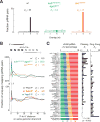Noncoding RNA. piRNA-guided transposon cleavage initiates Zucchini-dependent, phased piRNA production
- PMID: 25977554
- PMCID: PMC4545291
- DOI: 10.1126/science.aaa1264
Noncoding RNA. piRNA-guided transposon cleavage initiates Zucchini-dependent, phased piRNA production
Abstract
PIWI-interacting RNAs (piRNAs) protect the animal germ line by silencing transposons. Primary piRNAs, generated from transcripts of genomic transposon "junkyards" (piRNA clusters), are amplified by the "ping-pong" pathway, yielding secondary piRNAs. We report that secondary piRNAs, bound to the PIWI protein Ago3, can initiate primary piRNA production from cleaved transposon RNAs. The first ~26 nucleotides (nt) of each cleaved RNA becomes a secondary piRNA, but the subsequent ~26 nt become the first in a series of phased primary piRNAs that bind Piwi, allowing piRNAs to spread beyond the site of RNA cleavage. The ping-pong pathway increases only the abundance of piRNAs, whereas production of phased primary piRNAs from cleaved transposon RNAs adds sequence diversity to the piRNA pool, allowing adaptation to changes in transposon sequence.
Copyright © 2015, American Association for the Advancement of Science.
Figures




Comment in
-
RNA. Phased piRNAs tackle transposons.Science. 2015 May 15;348(6236):756-7. doi: 10.1126/science.aab3004. Science. 2015. PMID: 25977536 No abstract available.
References
Publication types
MeSH terms
Substances
Grants and funding
LinkOut - more resources
Full Text Sources
Other Literature Sources
Molecular Biology Databases
Research Materials

